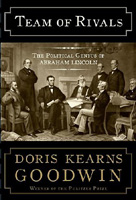

In short, this was not a Cabinet made in compatibility heaven.Ĭontrary to modern presidents’ approach to Cabinet-making, Lincoln wanted not compliant ciphers that he could ignore but men of accomplishment with their own base of support. Chase, Seward and Bates had been competitors for the GOP presidential nomination, and all of them, especially Chase and Seward, had a shockingly low regard for Lincoln’s abilities and promise.

Stanton as secretary of war and Edward Bates as attorney general. Chase as secretary of the treasury, William H. So Lincoln made a strategic decision to include his major Republican party rivals in his Cabinet: Salmon P. Even more than most chief executives, he needed all the help he could get. Goodwin’s theme is contained in the book’s subtitle: “The Political Genius of Abraham Lincoln.” When he became president in 1861, Lincoln had few strong allies in Washington he was mainly a stranger to the ways of this most political of cities, and he faced the dissolution of the Union in a matter of weeks. While the writing is a bit breezy at times and the details can be overwhelming in this 944-page volume, Goodwin has made Lincoln’s era and colleagues accessible to a public that needs a refresher course in real polarization. Noted popular historian Doris Kearns Goodwin attempts to paint the full portrait of the collective Lincoln presidency in her new book Team of Rivals.

Lincoln had a Cabinet full of remarkable men in their own right, and they helped - or hindered - the president as he strove mightily toward his goal. And one man, Abraham Lincoln, was determined to make us the United States again. We were literally, not just figuratively, the Divided States of America.

But America’s polarization in 2005 pales to white compared to the polarization during the Civil War. We often hear that we are living in an age of political polarization, and it’s true. Team of Rivals: The Political Genius of Abraham Lincoln (Book Review) Close


 0 kommentar(er)
0 kommentar(er)
